

Why application-specific blockchains make sense – Cosmos Blog. Cosmos enables developers to easily build and deploy scalable and interoperable application-specific blockchains.
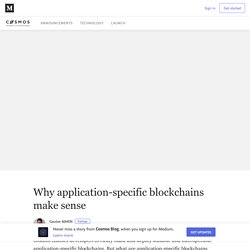
Atomic Swaps Explained: Swap Cryptocurrencies P2P Without Mediation. Why Are Atomic Swaps Important?
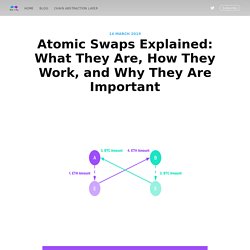
Prior to Bitcoin, transactions suffered from the inherent weaknesses of a trust-based model. Such models require parties to depend on institutions to facilitate transactions and reverse them in case of disputes. Lacking transaction finality, the need for trust spreads and parties involved in a transaction inherit the cost of mediation. The cost of mediation is typically expressed through fees and higher prices. As alternatives, Bitcoin, Ethereum, and other cryptocurrency networks aim to offer natively secure and peer-to-peer (P2P) ways to transact. Centralized exchanges (eg. Pass on more costs to their users, and Act as systematic points of failure As such, it is critical to build solutions that disintermediate if we are to realize the potential of P2P programmable money. Atomic Swaps exemplify the application of irreversible transactions and escrow mechanisms. Trusting their counterparty, andRequiring mediation through a trusted third party.
Stellar consensus protocol. ZBX Exchange Platform. Home - DAppNode Docs. Nakamo.to.
Directed acyclic graphs (DAGs) - BitcoinWiki. This is the approved revision of this page, as well as being the most recent.
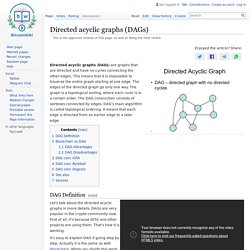
Enjoyed the article? Share: Directed acyclic graphs (DAGs) are graphs that are directed and have no cycles connecting the other edges. This means that it is impossible to traverse the entire graph starting at one edge. The edges of the directed graph go only one way. What is a Directed Acyclic Graph (DAG)? Let’s talk about the directed acyclic graphs in more details. It’s easy to explain DAG if going step by step. So, DAG is a graph, where edges go in one direction and it has no cycles – you will never come to the beginning or to the same node.
Next – the DAG construction, which is made of nodes and edges. The DAG algorithm is called topological ordering. Actually, the blockchain and DAG are rather relatives, but still competitors. DAG has obvious advantages over the blockchain: DAGs have a good scalability which means the high speed of transactions. Hedera Hashgraph. The Web Ledger Protocol 1.0. Mimblewimble. Mimblewimble est une conception de registre distribué basé sur une blockchain qui diffère en de nombreux points de celle de Bitcoin.
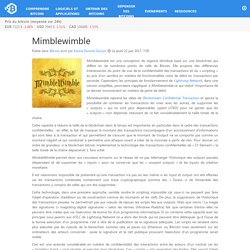
Elle propose des différences intéressantes du point de vue de la confidentialité des transactions et du « scripting » au prix d’un sacrifice en matière de fonctionnalités voire de débit en transactions par seconde. Cependant, les principes de fonctionnement de Lightning Network, dans une version simplifiée, pourraient s’appliquer à Mimblewimble ce qui réduit l’importance de ce dernier inconvénient en matière de perte de débit.
Mimblewimble reprend les idées de Blockstream Confidential Transaction et ajoute la possibilité de combiner les transactions les unes avec les autres, de supprimer les « outputs » qui ne sont plus dépensables (spent UTXO) pour ne garder que les « outputs » non dépensés réduisant de ce fait considérablement la taille totale de la chaîne. L’implémentation en cours de développement, GRIN, est un altcoin. Références : Hyperledger - Hyperledger - Hyperledger Confluence. Blockchain for Business - An Introduction to Hyperledger Technologies. Introduction — hyperledger-fabricdocs master documentation. SAFE Network.
Quickstart · IOST Docs. This page provides a guide for different kinds of users to find out which parts in the documentations to look at.
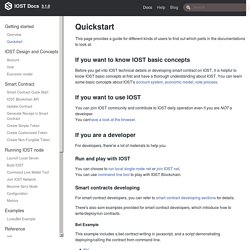
If you want to know IOST basic concepts Before you get into IOST technical details or developing smart contract on IOST, it is helpful to know IOST basic concepts at first and have a thorough understanding about IOST. You can learn some basic concepts about IOST's account system, economic model, vote process. Tendermint Documentation.
Crypto Scam Checker. Arbre radix. WhatToMine - Crypto coins mining profit calculator compared to Ethereum. BlockchainHub - Blockchain, Smart Contracts, ICOs, Tokens & Web3. Learn Blockchain Coding & Much More. We’ll help you get clarity. Blockchain Ratings - Prices, ICOs, IEOs, Exchanges, News - CoinSchedule. Bitaddress.org. A Bitcoin wallet is as simple as a single pairing of a Bitcoin address with its corresponding Bitcoin private key. Such a wallet has been generated for you in your web browser and is displayed above.
To safeguard this wallet you must print or otherwise record the Bitcoin address and private key. It is important to make a backup copy of the private key and store it in a safe location. This site does not have knowledge of your private key. If you are familiar with PGP you can download this all-in-one HTML page and check that you have an authentic version from the author of this site by matching the SHA256 hash of this HTML with the SHA256 hash available in the signed version history document linked on the footer of this site. A comprehensive guide to coding a blockchain-powered online community. At Hashnode we have been experimenting a lot with blockchain and its use-cases.

We have been running a developers’ community ourselves, and the idea behind “decentralized communities” fascinates me a lot. The fact that everyone owns the data and controls the platform can give rise to new types of social apps and disrupt the traditional way of building online communities. Platforms like Steemit have proven that it’s possible to build such communities and reward users for their contributions. But how should someone go about replicating it and launching their own decentralized social platform powered by blockchain?
To answer the question, I took up the challenge of building a decentralized version of HackerNews. During the process, I evaluated multiple platforms and finally zeroed in on a protocol called Tendermint. The codebase is on GitHub. Blockchain Consensus - Tendermint. Building Blockchain in Go. Part 1: Basic Prototype · Going the distance. Chinese translations: by liuchengxu, by zhangli1.
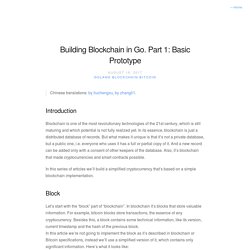
Introduction Blockchain is one of the most revolutionary technologies of the 21st century, which is still maturing and which potential is not fully realized yet. Hyper Ledger Foundation. Stellar - Develop the world's new financial system. ProtoSchool. IPFS Documentation.